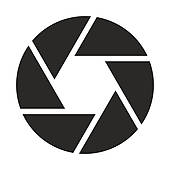Assignment Unit 2
How deep is your focus? How sharp is your eye?

Depth of Field
 For the assignment, you are to shoot three pairs of photographs, each at a different aperture (lens opening}. Try to use f/2 and f/11( or f/4 and f/16) as the pairs. Don’t use pairs that are only one f/stop apart, say f/4 and f/5.6, as they are too similar to see any dramatic change.
For the assignment, you are to shoot three pairs of photographs, each at a different aperture (lens opening}. Try to use f/2 and f/11( or f/4 and f/16) as the pairs. Don’t use pairs that are only one f/stop apart, say f/4 and f/5.6, as they are too similar to see any dramatic change.
Remember you also HAVE TO adjust your shutter speed and/or your ISO to accomplish these two very different f/stops. (TIP: Generally if you are handholding, and not using a tripod or bracing you camera in some way, the rule of thumb is keep your shutter speed to 1/’lens focal length’. So a 50mm lens wouldn’t be hand held at a slower speed than 1/50 (or closest) in order to presume sharp, non-shaky, images.)
Procedurally, you need to photograph something very close to you (to see maximum effect), with a distinctive background, and after focusing, leave the focus alone while you change the exposure and shoot at both those f/stops. See the examples. Again DON’T RE-FOCUS when you do this. (Use manual focus on your lens if you need to assure that the focus isn’t changed.) You should see, when you review the images on the camera’s LCD, and obvious difference in the “depth’ of you focus, from near to far, in the two images. Exposure-wise, they should look alike. If you can accomplish this without moving the camera at all, you’ll see the nicest comparison.
So, for example, if you are inside in very good light and shoot at ISO 200 at f/2 at 1/125, then you’ll need to change your shutter speed and ISO to shoot again at f/11, say. This is a five-stop change, from f/2-2.8-4-5.6-8-11. Each step a smaller “hole’’ so less light. So you need to slow you shutter speed down, but going below 1/60 invites a shaky picture. So you can slow it down for one of the stops. Then go to your ISO and increase it four more stops, so you’d go from 200-400-800-1600-3200.
That is, ISO 200 at f/2 at 1/125 gives the same Exposure as ISO 3200 at 1/60 at f/11, if in the same light. But it is the change of f/stops that changes the look of the photos. (As will the change in ISO, but that’s not our real interest here.)
That is just an example. You’ll have to determine the correct exposures for each f/stop by looking at your meter.
Shoot three pair of these, one an object at close focus, another a face portrait focused on the near eye, and finally your choice. But don’t shoot any pairs where everything is at infinity unless you include an obvious foreground. Why not?
Load these into the assignment folder online.
